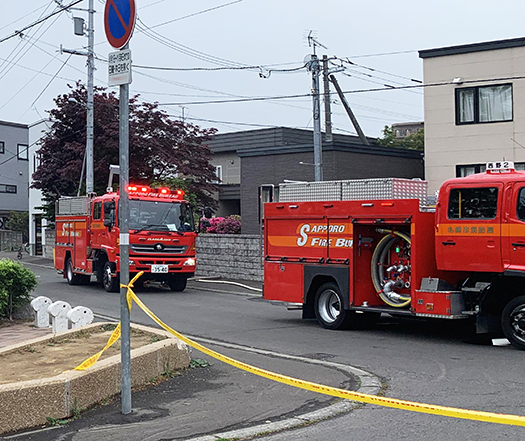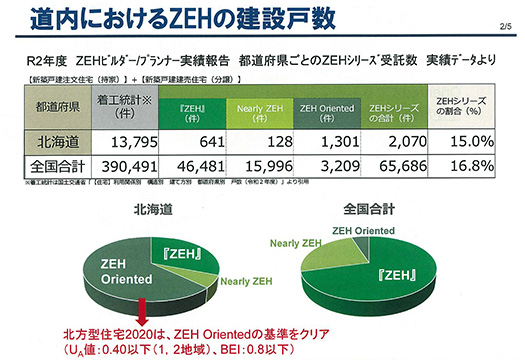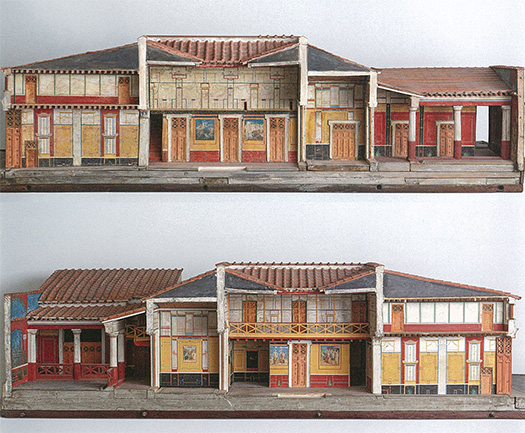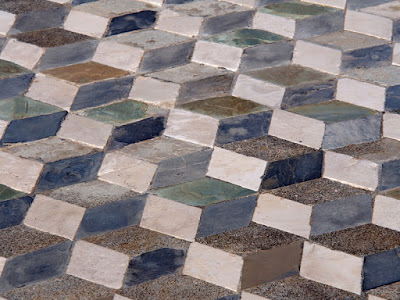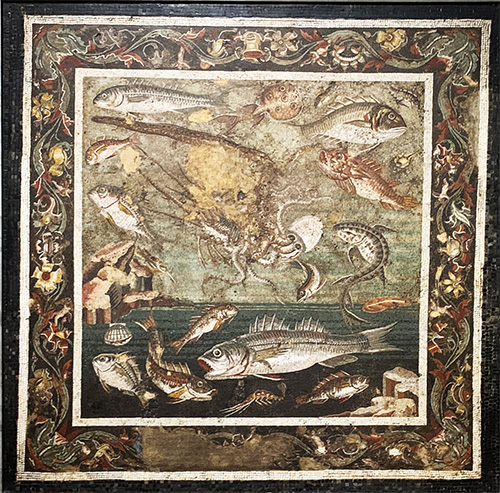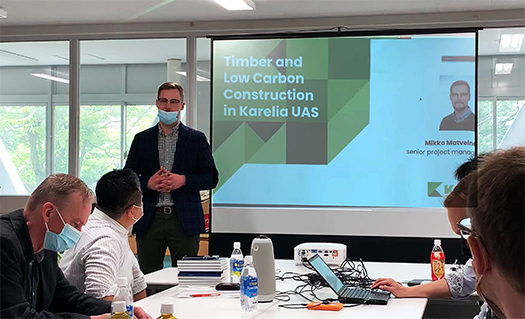
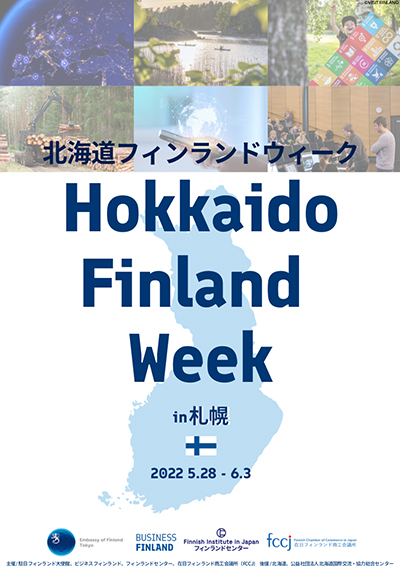
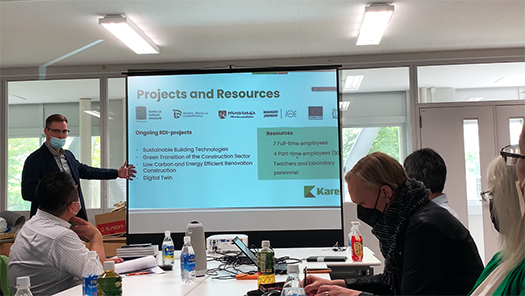
国レベルでの出入国制限の緩和が進んできたタイミングで
いま北海道とフィンランドとの交流週間が行われています。
ロシアによるウクライナ侵攻という緊張する情勢の中で
今回ツアーにはロシアと国境を接している「カルヤラ」の州知事も参加。
<参加は公的なものではなく個人としての参加とのこと>
フィンランドの南東部からロシアの北西部にかけて広がる
森林と湖沼の多い地方名。そこに住む人たちのことをカレリア人と呼ぶ。
フィンランド、ロシア、スウェーデンにとって歴史的にも重要な地方。
こういったタイミングでロシアと国境を接する日本の北海道との
積極的な交流というのはなんとも示唆的なものを感じさせる。
もちろん北海道は日米同盟という安保枠組みがあり、また海という
天然の防衛ラインもあるので陸続きのかれらとの体感温度差は存在する。
しかし北海道とほぼ同じくらいの人口の国がこのタイミングで
NATO加盟を申し出て、それを女性首相が直接プーチンに電話で伝えたという。
まさに刃先の上での外交を戦う強い勇気を示している。
はるかにリスペクトの念を強くする。
しかもこのサンナ・マリン首相は5月11日には訪日して岸田さんとも
公式会談している。フィンランド側の対日視線に並々ならぬものが伝わる。
君子の兵法ではないけれど「近攻遠交」の動きとすぐにわかる。
フィンランドとしては対日外交のなかでもとくに北海道の地政的位置を
十分に考慮に入れての今回のウィーク開催と友好活動であることがわかる。
昨日は北海道大学工学部・森太郎教授がホスト役になっての
脱炭素に向けての相互理解と協力関係構築の機会。
先生からは急な申し出でもあったのですが、上記のような背景を感じて
背筋を伸ばしながら対話機会に臨ませていただいた次第。
写真は基調的なプレゼンをされたMikko Matveinenさん。
カレリアの「応用化学科大学」のManagerという方。
タイトルを見ると「木造と低炭素志向建築」というテーマ内容でした。
当地での木造高層階建築の取り組みについて紹介されていました。
内容についてはほぼわたしたちの志向性と同じだと感じさせられます。
フィンランドの方たちは北欧圏全体そうですが、
基本的には英語でのコミュニケーションを必須としているので、
会議自体は日本語と英語のコングロマリットで進行していました。
わたしは単語と話される内容の類推でおおまかに理解しながらの対話。
知事さんとお話ししたときも、長く英語で話されると細部は不明になる。
そういう旨、話すと逆に「メールなどで会話すれば翻訳可能なので・・・」
というようなお話しを返されていました。人類交流進化の歴史段階。
具体的な中身についての詳細な詰めよりも
相互交流して相互理解と人間関係を深めようという強い意思を感じる。
前段で触れたようなことがらがより重要と考えている様子がわかります。
この項、あした以降に続きます。
English version⬇
Dialogue with Finland, which is adjacent to Russia, on “Zero Carbon for Buildings.
Female Prime Minister Sanna Marin daringly declares to Putin, “We will join NATO. The intention is to deepen ties with Hokkaido, a “neighboring country”. …
The timing is right for the relaxation of immigration restrictions at the national level.
Hokkaido and Finland are currently holding a week of exchange.
In the midst of the tense situation of the invasion of Ukraine by Russia, the tour will be joined by the governor of “Karjala”, which borders Russia.
The governor of Karjala, which borders Russia, also participated in the tour.
<The governor of Karjala, which borders Russia, is also taking part in the tour, but his participation is not official.
The region stretches from southeastern Finland to northwestern Russia.
A region with many forests and lakes stretching from southeastern Finland to northwestern Russia. The people living there are called Karelians.
The region is historically important for Finland, Russia, and Sweden.
The region is also historically important to Finland, Russia, and Sweden, and the active exchange with the Japanese island of Hokkaido, which borders Russia, is a very good opportunity.
The active exchange with Japan’s Hokkaido, which borders Russia, is very suggestive.
Of course, Hokkaido has a security framework in the form of the Japan-U.S. Alliance and a natural defense line by sea.
Hokkaido, of course, has the security framework of the Japan-U.S. Alliance and the natural defense line of the sea, so there is a difference in temperature between Hokkaido and Russia, which is connected by land.
However, a country with a population roughly the same size as that of Hokkaido
The prime minister called Putin directly and told him that the country, which has a population about the same size as that of Hokkaido, has offered to join NATO at this time.
It shows strong courage to fight diplomacy on the very edge of the knife.
It makes me respect her far more strongly.
Moreover, Prime Minister Sanna Marin visited Japan on May 11 and had an official meeting with Mr. Kishida.
She also had an official meeting with Mr. Kishida. This shows that the Finnish side has an extraordinary perspective toward Japan.
It is not the Art of War of the Emperor, but it is easily recognized as a move of “close attack and long distance exchange.
Finland’s diplomacy with Japan has been particularly focused on the geopolitical position of Hokkaido.
This is a clear indication that Finland has taken Hokkaido’s geopolitical position into consideration in its diplomacy with Japan, and is now holding this week and its friendship activities.
Yesterday, Professor Taro Mori of Hokkaido University’s Faculty of Engineering served as host for the
The event was an opportunity to build mutual understanding and cooperation toward decarbonization.
It was also a sudden offer from the professor, but I felt that the above background
I was able to participate in the dialogue with my back straightened.
The photo shows the keynote presentation by Ms. Mikko Matveinen.
The photo shows the keynote presentation by Ms. Mikko Matveinen, a manager at the University of Applied Chemistry in Karelia.
The title of the presentation was “Wooden Construction and Low Carbon Oriented Architecture.
He introduced the local efforts to build wooden high-rise buildings.
The content of the presentation was almost the same as our orientation.
The Finnish people, as in the entire Nordic region, communicate in English.
The meeting itself was a conglomeration of Japanese and English.
The meeting itself was conducted in a conglomerate of Japanese and English.
I was able to understand the conversation roughly by using words and analogies of what was being said.
When I spoke with the governor, he said that when he speaks in English for a long time, the details become unclear.
When I told him this, he responded, “I can translate if I talk to him by e-mail…”
He replied, “It is possible to translate if you talk to me by e-mail…”. The common historical stage recognition of mankind.
Rather than elaborating on the specifics
I sense a strong will to deepen mutual understanding and human relations through mutual exchange.
I can see that they consider the things I mentioned in the previous section to be more important.
This section will be continued in the next section.
Posted on 6月 3rd, 2022 by 三木 奎吾
Filed under: 住宅マーケティング, 状況・政治への発言 | No Comments »


